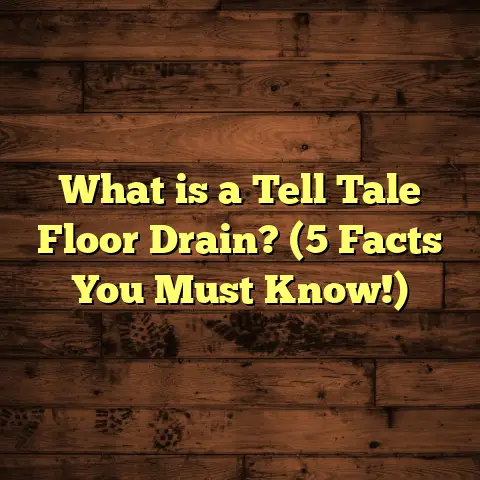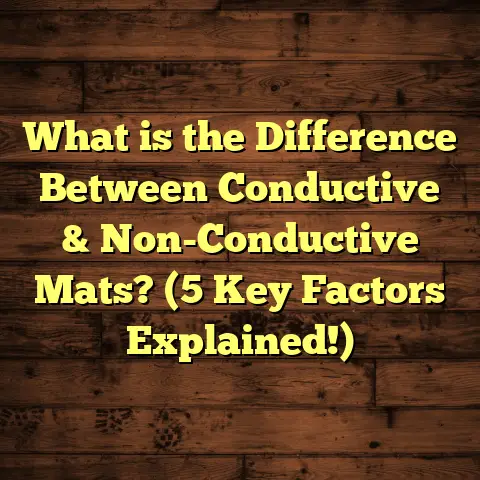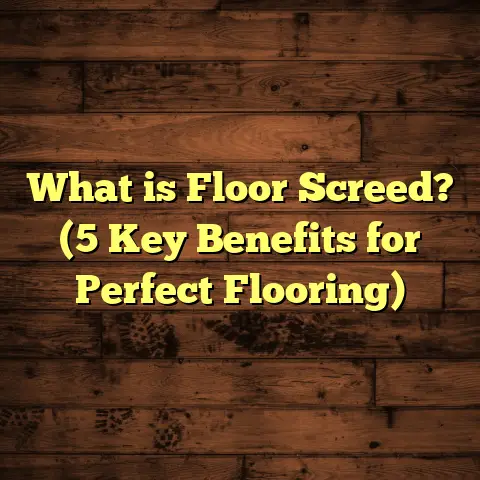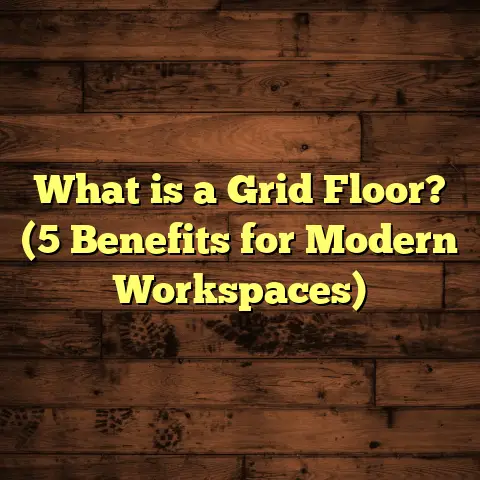What is Floating Vinyl Sheet Flooring? (5 Benefits You Need)
I want to share a little secret that not many people talk about in the flooring world: floating vinyl sheet flooring. It’s like the unsung hero of flooring options—affordable, practical, and surprisingly stylish. If you haven’t heard much about it or have only a vague idea, you’re about to discover something that could change the way you think about flooring for your home or project.
I remember the first time I encountered floating vinyl sheet flooring during a renovation project for a client who was in a real hurry to finish their kitchen and living room floors. They wanted something durable but quick to install, and traditional hardwood or tile just wasn’t going to work within their timeframe or budget. After doing some research and trying it out myself, I realized this product was a game-changer.
I want to walk you through exactly what floating vinyl sheet flooring is, why it might be perfect for your space, and share some insider tips from my years of experience installing it. You’ll get detailed benefits backed by data and real-world examples so that you can make a confident decision—and maybe even save some money and time in the process.
What is Floating Vinyl Sheet Flooring?
Let’s start by answering the key question: what exactly is floating vinyl sheet flooring?
In simple terms, it’s a type of vinyl flooring that comes in large sheets—usually 6 to 12 feet wide—that are not glued or nailed down to the subfloor. Instead, the vinyl “floats” over the existing floor. The sheets can be loosely laid or locked together with special edges or tape, holding everything in place through their weight and design rather than adhesives.
Unlike traditional vinyl sheet flooring that requires glue for installation, floating vinyl sheets save a lot of time and hassle. The surface looks like one continuous floor without seams, and the design layer mimics natural materials like wood, stone, or tile very convincingly.
The sheets themselves consist of multiple layers:
- Wear Layer: This is a tough, clear protective coat that guards against scratches, stains, and daily foot traffic.
- Design Layer: Printed vinyl that gives the floor its appearance—wood grain, patterns, colors, textures.
- Core Layer: Provides stability; some products have waterproof cores to resist moisture damage.
- Backing Layer: Adds cushioning and sound absorption for comfort.
I first used floating vinyl sheet flooring for a kitchen remodel where we didn’t have time to wait for glue to dry. The whole process was surprisingly easy: we prepared the subfloor, rolled out the sheets, cut them to size with a utility knife, taped the seams tightly, and voilà— a beautiful floor installed in less than two days!
How Floating Vinyl Sheet Flooring Differs from Other Flooring Types
You may have heard of luxury vinyl tile (LVT) or luxury vinyl plank (LVP), which are other popular vinyl options. These come in smaller pieces like tiles or planks and are often glued down or clicked together as floating floors.
Floating vinyl sheet flooring sets itself apart because it comes in large continuous sheets, which means fewer seams and a more uniform look—great if you want that seamless wood floor vibe without the hassle of multiple plank installations.
Compared to laminate or hardwood floors, floating vinyl sheets are:
- Softer underfoot thanks to cushioned backing layers
- More water-resistant since vinyl naturally repels moisture
- Easier to install quickly without specialized tools or adhesives
- Less expensive upfront and easier to maintain
5 Benefits You Need to Know About Floating Vinyl Sheet Flooring
From my experience, here are five reasons why floating vinyl sheet flooring is worth your attention:
1. Speedy and Simple Installation Saves You Time and Money
One of the biggest perks I’ve experienced with floating vinyl sheets is how fast installation goes. Because there’s no glue or nails involved, the process is straightforward. You just roll out the sheet over a smooth subfloor, cut it to fit, and lock or tape the seams in place.
This can cut down installation time dramatically compared to glue-down methods. For example, on one project, we installed 800 square feet of floating vinyl sheet flooring in just two days with a small crew. That kind of speed translates to lower labor costs and less disruption if you’re living in the space.
Plus, if you’re doing a DIY project, the simplicity makes it beginner-friendly. I always recommend checking the subfloor for flatness before installation because uneven surfaces can cause problems later.
A Personal Example:
During a job for a young couple renovating their condo, they were eager to get their floors done before moving back in. We got the floating vinyl sheets down in just under three days total, including prep work. They were amazed at how clean the process was—no glue smells or drying times. They even helped with taping seams!
If you’re comparing installation times between glued-down vinyl sheets (which can take a week or more) and floating vinyl sheets, you’ll see how much easier this option can be.
Installation Tips I Use Regularly:
- Always prep your subfloor by cleaning it thoroughly and making sure it’s level within 3/16 inch over 10 feet.
- Use a straight edge and sharp utility knife for cutting sheets precisely.
- Tape seams tightly with manufacturer-recommended seam tape to avoid gaps.
- Leave an expansion gap (usually 1/4 inch) around all edges so sheets can move slightly with temperature changes.
- Roll the floor after installation with a floor roller if recommended to ensure good seam adhesion.
2. Water Resistance That Works for Wet Areas
Vinyl as a material is naturally water-resistant, but floating vinyl sheet flooring takes this a step further. Since it’s not glued down, moisture from below the floor has less chance to cause damage compared to some glued products.
I installed floating vinyl sheet floors in several bathrooms and kitchens where water splashes are common. Over months of use, the floors held up beautifully with no warping or lifting. Some floating vinyl sheets even come with waterproof cores, making them suitable for basements or laundry rooms.
According to data from the Resilient Floor Covering Institute (RFCI), vinyl floors have water absorption rates below 0.5%, which is far lower than laminate or hardwood floors that can swell when exposed to moisture.
Why Does Floating Help?
Because the sheets aren’t glued down directly, any moisture that does get under the floor has fewer places to trap mold or cause adhesive failure. This makes floating vinyl sheets a practical choice in areas prone to humidity or minor water exposure.
Real-World Insight:
In one multi-family apartment complex I worked on, tenants had issues with water spills and occasional flooding. We installed floating vinyl sheet flooring throughout kitchens and bathrooms. Six months later, there were no complaints about mold or moisture damage—a problem they had experienced repeatedly with glued-down flooring before.
Pro Tip:
If you’re installing floating vinyl sheets in wet areas, be sure to seal seams carefully with waterproof seam tape. Also, consider additional vapor barriers under your subfloor if moisture is a concern (especially in basements).
3. Comfort and Sound Absorption That Surprises You
One thing I didn’t expect when I first tried floating vinyl sheet flooring was how comfortable it felt underfoot. Thanks to its cushioned backing layer, walking on it is much softer than wood or tile.
This cushioning also helps reduce noise — especially footstep sounds — which makes it ideal for multi-level homes or apartments where sound transfer can be an issue.
In my experience, clients with kids or pets appreciate this benefit because it makes their homes quieter and more comfortable without extra underlayment costs.
Science Behind It:
Studies show that cushioned resilient floors like vinyl can reduce impact noise by as much as 20 decibels compared to hard surfaces. That means less echoing footsteps and more peaceful rooms—something worth thinking about if you live in close quarters.
A Story from My Work:
I once installed floating vinyl sheet flooring in a daycare center where noise was a major concern. The management was worried about echoes from running kids on hard floors disturbing neighbors. After installation, the reduction in noise was noticeable immediately—parents and staff reported quieter play areas, and complaints from neighbors dropped sharply.
4. Cost-Effective Flooring Without Sacrificing Style
Budget is always a big factor when choosing flooring. Floating vinyl sheet flooring offers a great balance between cost and appearance. You can find styles mimicking hardwood grains, natural stones, or modern patterns at prices significantly lower than real wood or stone.
To give you some numbers: typical floating vinyl sheets run between $2 to $5 per square foot for materials, while hardwood floors can easily go $8 to $15 per square foot installed.
Labor costs also tend to be lower due to faster installation times—sometimes cutting labor by half compared with glue-down options.
On one large-scale renovation I managed recently, I used FloorTally—a tool I rely on—to calculate exact costs based on local labor rates and materials. It helped me prepare accurate budgets that avoided surprises during the project. FloorTally factors in waste percentages and different product options automatically, which means less guesswork when planning expenses.
My Advice on Budgets:
If you’re not experienced in pricing flooring projects, using an online calculator like FloorTally can save you hours of research. It lets you input your room dimensions, choose your material types, and get detailed estimates including labor costs in your area. This way you can compare options quickly without calling multiple contractors just for rough numbers.
5. Easy Repairs and Replacement Without Mess
What happens when part of your floor gets damaged? One of my favorite things about floating vinyl sheet flooring is how easy it is to fix.
Since the sheets aren’t glued down, you can lift up the affected section and replace it without tearing up the entire floor. This is much cleaner and more affordable than repairing glued-down floors where adhesive residues complicate removal.
I had a client who accidentally scratched their kitchen floor with a heavy appliance. Instead of a full replacement, we only replaced the damaged section in a couple of hours—no fuss, no mess.
More Repair Tips:
- Keep some extra material on hand after installation in case repairs are needed later.
- For minor scratches or scuffs, sometimes buffing with specialized cleaners designed for vinyl can restore appearance without replacement.
- Avoid dragging heavy furniture across the floor; use felt pads under legs to reduce wear spots.
Deeper Insights: Durability & Longevity Data
You might wonder how long floating vinyl sheet flooring actually lasts compared to other options. Here’s what my experience and industry data show:
- Quality floating vinyl sheets typically have wear layers between 12 mils (0.3 mm) and 30 mils (0.76 mm).
- Thicker wear layers mean better resistance against scratches, dents, and stains.
- A well-maintained floating vinyl floor can last between 10-20 years depending on traffic levels and care.
- By contrast:
- Hardwood floors last 20+ years but require refinishing every few years.
- Laminate lasts around 10-15 years but is less water-resistant.
- Carpet usually needs replacement every 7-10 years due to wear and staining.
One project I worked on had floating vinyl sheet floors installed in a high-traffic retail environment. After five years with thousands of visitors daily, the floors showed minimal wear—just some light scuffing easily cleaned away with commercial products. Replacing them wasn’t on the horizon yet thanks to their durability.
Design Flexibility: More Than Just Basic Floors
Floating vinyl sheet flooring isn’t just practical; it offers design versatility that surprised me early on.
Manufacturers now produce sheets with photorealistic prints mimicking wood grains, marble veining, concrete textures, and even artistic patterns for bold looks.
Because the sheets come in wide formats, you avoid repetitive plank patterns seen in LVP installations, giving your floor a more natural flow across large spaces.
Some of my favorite design choices have been:
- Wide plank wood-look designs for rustic kitchens
- Slate stone prints for modern bathrooms
- Subtle concrete textures for industrial-style lofts
If you care about aesthetics but don’t want to pay premium prices for real materials, floating vinyl sheets offer an excellent compromise between style and budget.
Addressing Common Concerns About Floating Vinyl Sheet Flooring
I often hear questions or worries from clients considering this option. Let me address some common points:
Q: Will it feel cheap?
Absolutely not. When installed properly over smooth underlayment, it feels firm yet soft underfoot. The cushioned backing adds comfort unlike hard tile or laminate floors.
Q: What about seams?
Seams are minimal due to wide sheet sizes. Using proper seam tape creates invisible joins that don’t open up over time when installed correctly.
Q: Can I install over existing floors?
Yes! Floating floors can often go over existing wood, tile, or concrete if they’re intact and level. This saves demolition costs but always check manufacturer guidelines.
Q: Is it environmentally friendly?
Vinyl production has environmental impacts like most synthetic materials. However, many brands now offer low-VOC products certified for indoor air quality. Recycling options are improving but still limited compared to natural materials.
More Personal Stories From My Projects
Sharing more real-life examples might help you picture how floating vinyl sheet flooring fits into different settings:
Story 1: The Busy Family Kitchen
A family with three kids wanted durable floors in their kitchen where spills were constant. We installed floated vinyl sheets with a wood-look design. After two years, the floor still looks great despite frequent messes, and mom loves how easy cleanup is—just mop or wipe spills immediately.
Story 2: Basement Renovation With Moisture Concerns
In an older home’s basement conversion, the homeowner was worried about moisture damaging floors. We chose floating vinyl sheets with waterproof cores plus vapor barriers underneath. After one year of basement use as a playroom, there are no signs of mold or swelling even after heavy rain seasons outside.
Story 3: DIY Installation Success
A DIY enthusiast friend took on installing floating vinyl sheet flooring in their apartment living room. Following manufacturer instructions closely, they completed it over two weekends. They saved roughly $1,000 on labor costs versus hiring pros, and were thrilled with how professional it turned out with seamless joints and great cushioning underfoot.
How I Use FloorTally To Help With Flooring Projects
Budgeting is often one of the trickiest parts of picking new flooring. When I’m managing projects—whether big commercial spaces or small residential rooms—I rely heavily on FloorTally for cost estimation.
This online tool lets me input local material prices (which vary widely across regions), labor rates, room sizes, and even waste factors so I get precise estimates upfront.
For example: On one recent job, FloorTally helped me compare costs between floating vinyl sheet flooring and glued-down luxury vinyl tiles side-by-side. The tool showed not only raw material costs but also labor savings from faster installation times. That insight helped clients make informed decisions instead of guessing blindly at prices.
I also appreciate how FloorTally accounts for extra material needed due to cutting waste—which many people forget until they run short mid-job!
If you want reliable budgeting support without endless calls for quotes, using FloorTally early saves stress later on your project timeline.
Maintenance Tips That Keep Floating Vinyl Sheet Floors Looking New
Maintaining floating vinyl sheet flooring is pretty straightforward but there are some do’s and don’ts I always share with clients:
Do:
- Sweep or vacuum regularly to remove dirt/grit that can scratch surfaces
- Mop occasionally using manufacturer-approved cleaners (usually mild solutions)
- Wipe up spills promptly before they dry
- Use protective pads under furniture legs
Don’t:
- Use abrasive scrubbers or harsh chemicals like bleach
- Drag heavy objects across floor without lifting
- Allow standing water for long periods—it’s water-resistant but not waterproof forever
By following these simple steps, floors stay vibrant for years without extra effort or costly treatments like refinishing required on hardwoods.
Final Thoughts: Is Floating Vinyl Sheet Flooring Right For You?
If you want practical floors that combine quick installation, water resistance, comfort, style variety, and affordability— floating vinyl sheet flooring deserves serious consideration.
It’s especially useful if:
- You’re renovating on a tight timeline or budget
- Need resilient floors in kitchens/bathrooms/basements
- Want something easy enough for DIY installation
- Prefer seamless looks over plank-style patterns
Personally, I’ve used this product on dozens of projects now—from family homes to commercial spaces—and haven’t been disappointed yet. The feedback from clients has been consistently positive regarding durability and ease-of-care as well.
So if you’ve been searching for a flexible flooring solution that doesn’t complicate your life— floating vinyl sheet flooring might just become your new best friend!
If you have any questions about selecting styles, prepping subfloors, or installation tricks I’ve learned along the way— just ask! I’m happy to share more tips tailored specifically for your project needs.





